Writing content is one of the most useful tools to market your website and gain visitors. Using different types of content writing on your business platform can help your website retain more users without having to spend tens of thousands on ads.
But writing content is easier said than done, especially if you are just out there starting a website for the first time. Taking care of all the nitty gritties of content can be overwhelming. If you feel uncertain about how to proceed, you could always outsource your content creation strategy to an agency/company . It will ensure you get a good ROI and leave you free to deal with other aspects of your business.
However, if you are already clear with the basics of SEO optimized content – this blog should help you with brush through the various content types and their use cases. Let us go through it one at a time and talk about which types of content works and when.
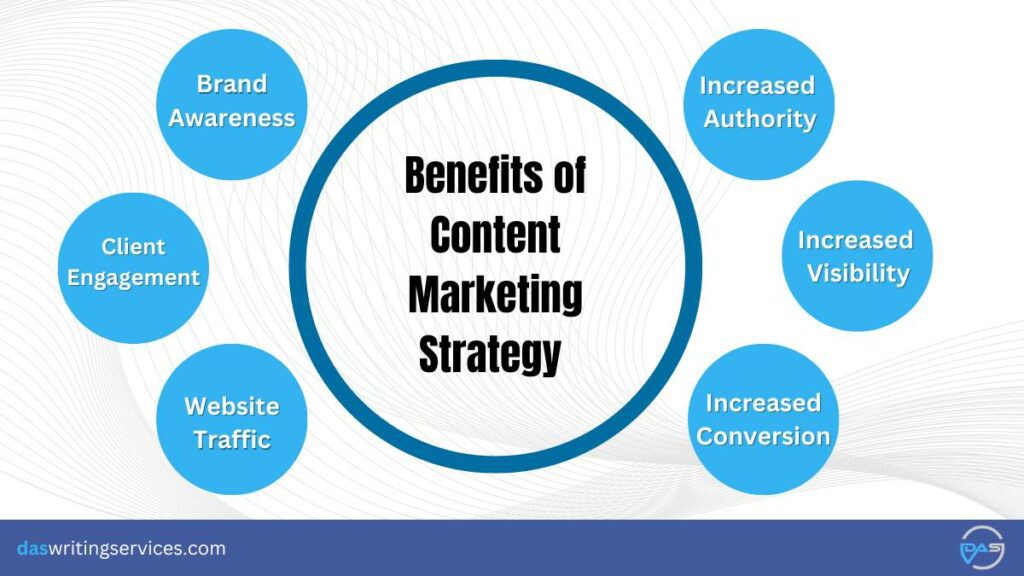
9 Essential Types Of Content Writing You Must Use in 2025
Content writing never works with a one size fits all approach. As content specialists we have noticed, a content strategy that works for a particular site, does not always produce similar growth for a business in the same industry. It is not about the types of content as much as it is about effectively personalizing your content as per the target audience.
1. Blogs
SEO blogs are meant to spread awareness about your brand and satisfy the search query of a user. Competitor research, excellent keyword planning and execution, and abiding by Google algorithm requirements are the hallmarks of top-quality SEO.
Compared to PPC ads, which may or may not succeed but require a certain expenditure, if you rank high on the SERP, you will attract web traffic at a significantly lower cost, thus boosting your ROI.
Written content helps build credibility and authority in a specific field. You must do a thorough analysis of your target audience and use tools like Ahrefs and Semrush to get the best results.
Most blogs have a word count in the range of 1200 to 2500, but the exact figure can vary as per the demands of the content and how competitors have written about the same topic. Some examples of blogs are:
- Listicles
- How-to guides
- Informative content such as a comparison of different products
- Reports and statistics
Some of the world’s most famous blogs include TechCrunch, The Verge, and Engadget.
When to Use:
- To attract new website visitors
- Retain more audience (longer time on website = better conversion potential)
- Grow website traffic
- Improve organic visibility
2. Infographics
infographics are highly effective in capturing the audience’s attention and conveying information in a visually appealing way.
You can easily understand complex data and information with infographics. You can use tools like Canva, Adobe Illustrator, and Piktochart to create data-rich infographics.
When to Use:
- Enhance brand authority
- Establish thought leadership
- Image link building
- Offer better data visualization
3. Social Media Posts and Microcontent
Social media platforms, such as Facebook, Instagram, Twitter, and LinkedIn, have become essential types of content writing.
The type of writing you do depends on the platform you use. For example, Facebook and LinkedIn are better suited to long-form content.
On the other hand, platforms like Instagram and Pinterest are suited to visual content with minimal text. Short-form content, including social media posts, microblogs, and status updates, allows for quick and frequent communication with audiences. These bite-sized pieces of content are highly shareable and can drive engagement, directing users to more substantial content pieces on a website or blog. You can learn more about choosing the right content type by taking cues from content writing examples.
When to Use:
- Target end consumers
- Promote products and services
- Enhance brand recall value
- Drive more audience engagement
4. Ebooks and Whitepapers
E-books and whitepapers are comprehensive, long-form content pieces that provide valuable insights, detailed guides, or research findings on specific topics.
These content assets can be used as lead magnets and exchanged for user information like email addresses. E-books and whitepapers position businesses as industry experts and thought leaders, and help in attracting and nurturing leads.
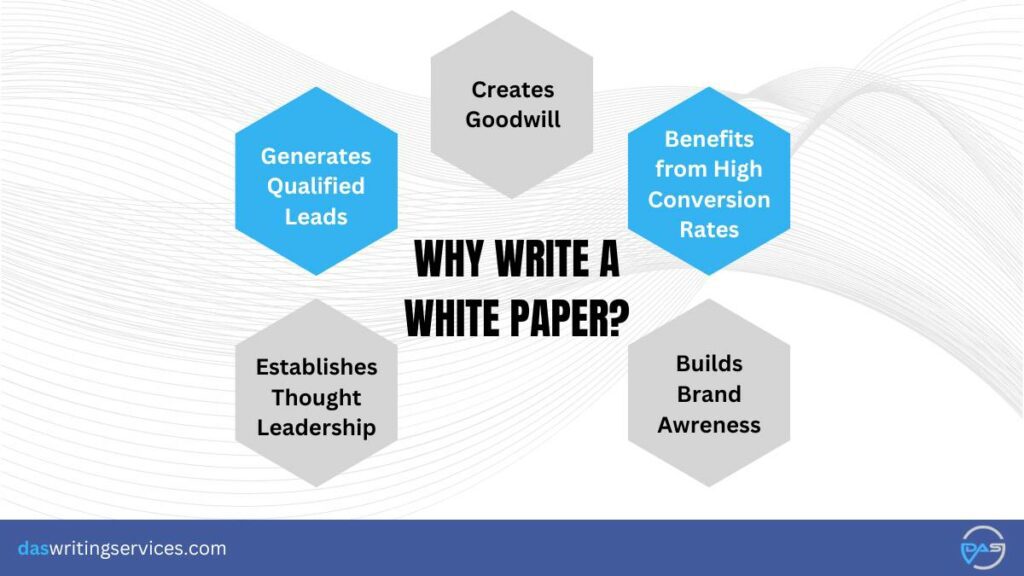
When to Use:
- To educate readers
- Solve complex industry probelems
- Use as lead magnets
- Establish industry expertise
5. User-Generated Content
User-generated content (UGC) involves leveraging the content created by your audience and customers. Online polls, comments on your social media posts, and online reviews are common types of content writing which come under this category.
UGC is powerful because it showcases authentic experiences and builds social proof. For example, your website can highlight positive testimonials about your products and services.
Encouraging your audience to share their stories and experiences with your brand not only increases engagement but also creates a sense of community and trust among your audience.
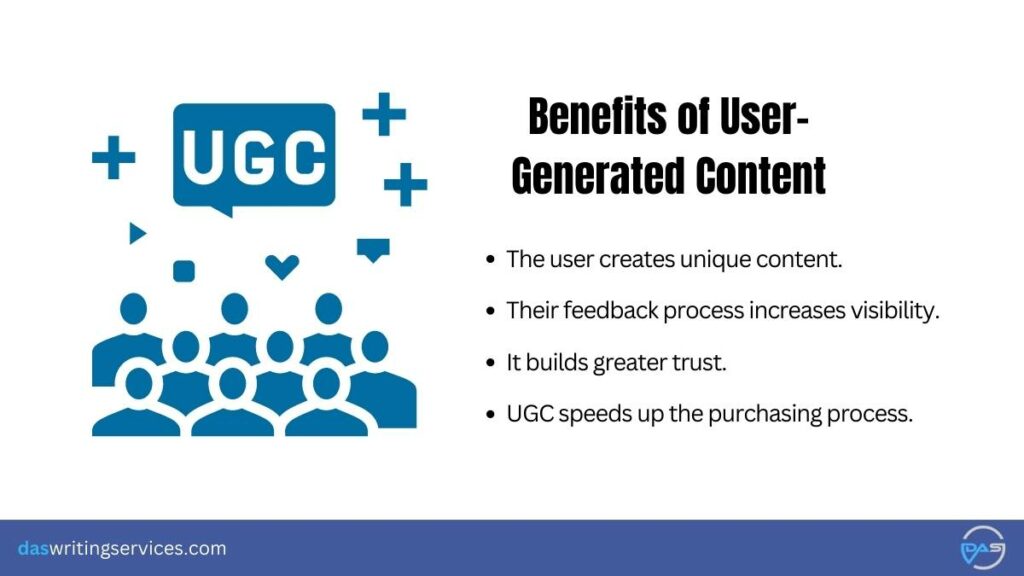
When to Use:
- Instill trust among the end consumer
- Send vital trust signals to boost conversion
- Reduces abandoned carts
- Especially useful for eCommerce
6. Technical Writing
Technical writing is a broad term which includes:
- Reports
- User Manuals
- Standard Operating Procedures (SOP)
- API Documentation
- Press Releases
- Company Documents
- Annual Reports
This type of writings serve an instructional purpose rather than being strictly promotional. It aims to inform and educate the target audience. Technical writing breaks down complex concepts into easily understandable language. You must acquaint yourself with different types of technical writing to decide which suits you the best.
When to Use:
- To engage B2B audience
- Attract technically sound industry experts
- Streamline accessiblity to the end consumer
- Inform users on niche topics
7. Case Studies and Success Stories
Case studies and success stories highlight real-life examples of how your product or service has made a positive impact on customers.
They provide evidence of your capabilities and build trust among potential customers. Case studies often include in-depth information about a problem, solution, and measurable results. Key elements of a good case study are:
- A comprehensive study of an issue
- Problems faced in solving problems
- Details of successes with evidence
- Quotes, and testimonials highlighting your positive contribution
Sharing success stories not only showcases your expertise but also helps potential customers understand how your product or service can benefit them.
When to Use:
- Claim authority in the niche
- Showcase problem solving abilities
- Useful to attract B2B clients
- Inspire faith
8. Newsletters and Email Campaigns
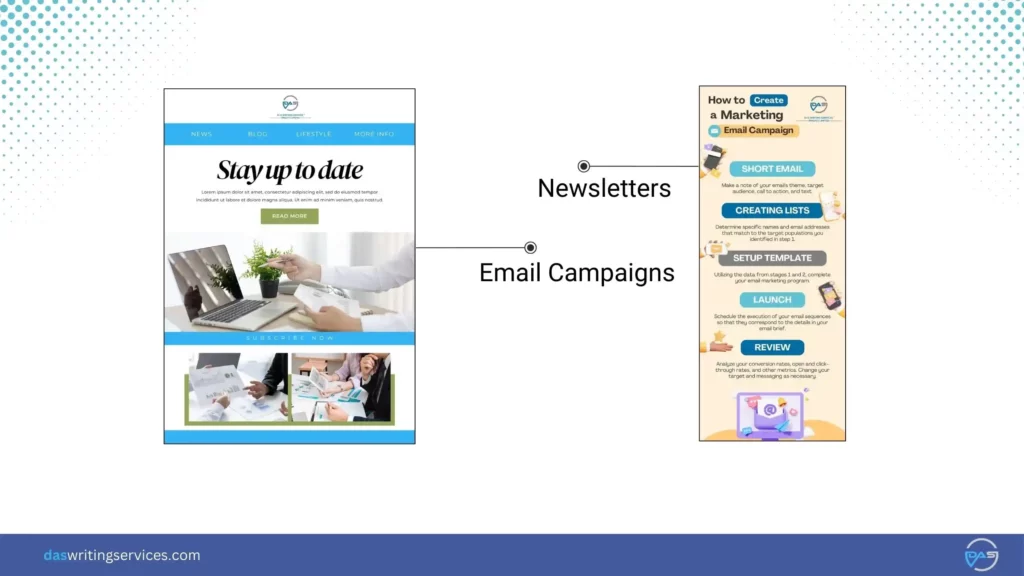
Email marketing is a powerful way to nurture relationships with your audience and keep them updated with valuable content.
They allow you to deliver curated content, exclusive offers, and personalised messages directly to your subscribers’ inboxes. Email newsletters also help strengthen brand loyalty, drive traffic to your website, and increase conversions.
Newsletters are often long-form and they aim to update the audience about a topic. On the other hand, email campaigns focus on events and promotions such as special sales or product launches.
When to Use:
- Contribute value to the audience
- Encourage journey through the marketing funnel
- Nurture potential clients by offering value
- Establish industry authority
9. Press Release
Press releases are official statements shared with the media to attract attention and coverage regarding a particular event, product, or organization. Crafting an effective press release demands a solid grasp of journalistic writing techniques, along with the skill to articulate essential messages clearly and succinctly. Companies, non-profit entities, and government bodies use press releases to engage with both the media and the general public.
When to Use:
- Create market reputation
- Scaling operations
- Promote an Impact
- Inform about new product launch
Did it all confuse you? Don’t worry, reach out now and get a sample suitable for your requirements:
Elements of a Successful Content Writing Strategy
- Clearly Defined Objectives: Start by identifying your content marketing objectives. Clearly defining your goals will guide the rest of your strategy.
- Target Audience Research: To understand your target audience, conduct thorough research to identify their demographics, preferences, needs, and pain points. This information will help you create content that resonates with your audience and delivers value.
- Content Planning and Creation: Create a content calendar that outlines the types of content writing you will use, the topics you will cover, and the publishing schedule. Focus on producing high-quality, relevant, and valuable content that addresses your audience’s needs.
- Content Distribution and Promotion: Creating great content is not enough; you also need to ensure it reaches your target audience. Try to reach your audience through various channels such as social media, email marketing, SEO optimization, influencer partnerships, and paid advertising.
- Search Engine Optimization (SEO): Implement SEO strategies to increase the visibility and discoverability of your content. Conduct keyword research and ensure your website is optimised for search engines. Content should be optimised because 95% of people only look at the first page of search results.
- Engaging and Shareable Content: To create engaging and shareable content, incorporate visual elements, and interactive features to capture and retain your audience’s attention. Encourage social sharing to amplify your reach.
- Performance Measurement and Analysis: Regularly track and analyse the performance of your content marketing efforts. Monitor metrics such as website traffic, engagement, social shares, conversions, and customer feedback. Use analytics tools to gain insights and make data-driven decisions to optimise your strategy.
- Integration with Overall Marketing Strategy: Align your content writing strategy with your overall marketing objectives and initiatives. Ensure consistency in messaging, branding, and communication across all channels to create a cohesive and unified brand experience for your audience.
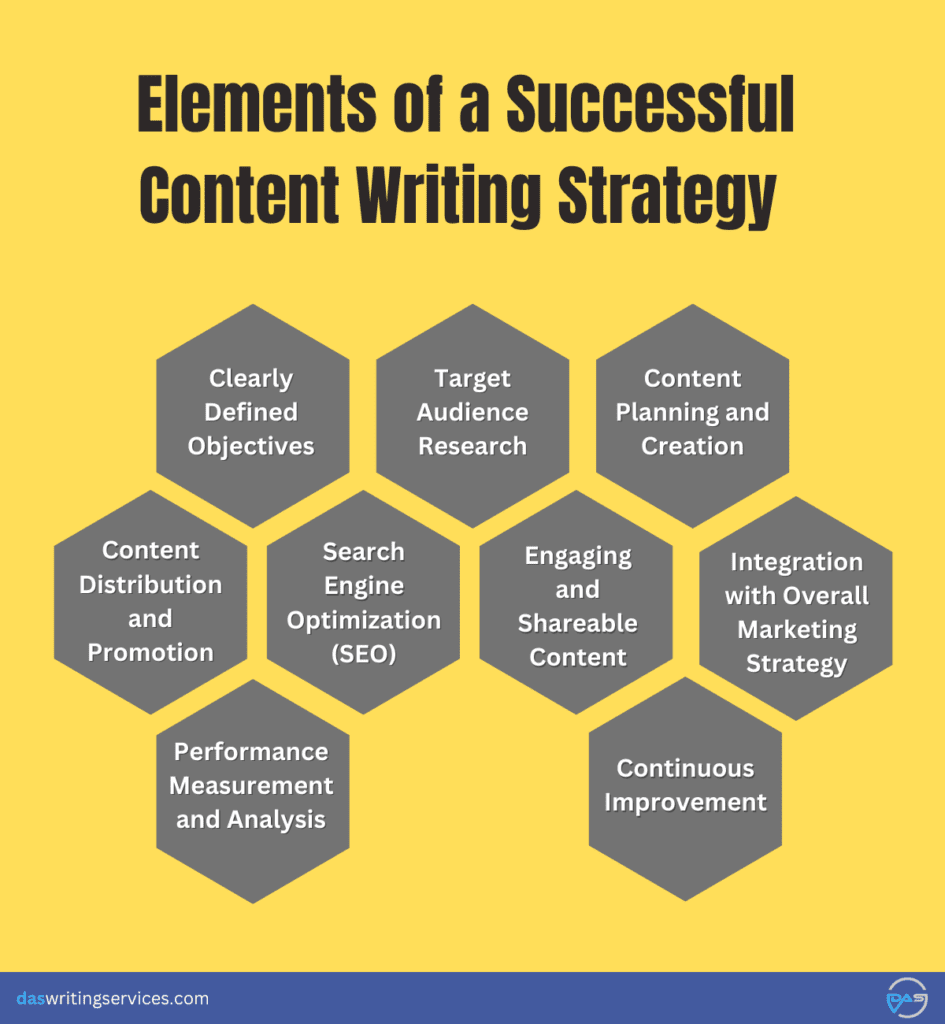
Importance of content writing strategy
A well-defined content marketing strategy is essential for businesses for several reasons. Here is why different types of content marketing strategies are important:
1. Audience Engagement and Connection
Using various types of content writing allows businesses to engage and connect with their target audience on a deeper level. By creating valuable and unique content, businesses can also provide information, insights, and solutions that address their audience’s needs and pain points. This builds trust, establishes credibility, and fosters a relationship between the business and its audience.
2. Brand Awareness and Visibility
Content writing plays a crucial role in increasing brand awareness and visibility. By consistently publishing and promoting high-quality content, businesses can expand their reach and attract a wider audience. When done effectively, content marketing positions the brand as an industry authority and creates a positive brand perception in the audience’s mind.
3. Lead Generation and Conversion
Content writing is an effective tool for generating leads and driving conversions. Create valuable content to capture the attention of potential customers and nurture them through the buyer’s journey. Well-crafted content can educate, inform, and persuade the audience, ultimately leading to increased conversions and sales.
4. Customer Retention and Loyalty
Content marketing is not only about attracting new customers; it is also crucial for customer retention and loyalty. By consistently delivering valuable content even after the purchase, businesses can keep their existing customers engaged and satisfied. This builds brand loyalty, encourages repeat purchases, and increases customer lifetime value.
5. Competitive Advantage
By consistently producing valuable content businesses can stand out and position themselves as industry leaders. A strong content writing strategy can help businesses stay ahead of the competition and capture the attention of their target audience.
Takeaway
Choosing the right type of content writing depends on factors such as the target audience, objectives, and the resources available. Blogs, infographics, videos, podcasts, social media posts, e-books, webinars, etc. provide ample opportunities to connect with audiences, drive engagement, and achieve content marketing goals. So, by diversifying content formats and experimenting with different channels, businesses can effectively reach and resonate with their target audience in an increasingly competitive digital landscape. Remember, the key is to consistently produce high-quality content that adds value and speaks directly to the needs and interests of the audience.
Frequently Asked Questions
1. What are the pillars of content writing?
The important pillars of content writing are – knowing your target audience; setting the tone and researching the information you want to deliver; setting a consistent and relevant tone; and delivering high-quality content with consistency.
2. How does user-generated content benefit businesses?
User-generated content (UGC), such as customer reviews, social media posts, and testimonials, boosts authenticity and trust. It shows potential customers real experiences with the brand, influencing their purchasing decisions positively.
3. Can humour be used in website content writing for businesses?
Yes, humour can be effective if used appropriately and aligned with the brand’s tone. It can create a positive and memorable experience for visitors, but it should not overshadow the core message or be offensive.
4. Can businesses repurpose content for different platforms?
Absolutely! Repurposing content involves adapting existing material (e.g., blog posts) to suit different platforms like social media, videos, or Infographics. It saves time while reaching a broader audience and reinforcing key messages.
5. Should businesses allow comments on their blog posts?
Yes, of course! Enabling comments encourages audience engagement and interaction. However, businesses should actively moderate comments to maintain a positive and respectful environment.







Leave a comment